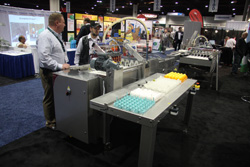New IPE formula seems well received

The annual IPE show in Atlanta, USA used to primarily be a tradeshow for the global poultry business. Now a wide range of side-events have also been added, and its timing has changed. This adjusted formula seems to work well as again a large crowd came to Atlanta, despite the absence of some major exhibitors.
By Ad Bal
The annual International Poultry Exposition (IPE) including the International Feed Expo (IFE) was held again in Atlanta, GA, USA last January. Unlike in previous years, the greatest change of this years’ IPE was its timing. In order to keep more exhibitors and visitors in Atlanta until the very end of the show, it started on Tuesday afternoon, rather than in the years before on Wednesday morning. Thus, it could end this time on Thursday afternoon.
Along with this new timing, IPE extended its activities by organising a number of side-events. The objective was to make the show more comprehensive and keep it attractive in order to be held annually as has been the case for decades. But since the so called Showco group of companies decided to only participate every other year, IPE lost some of its exposure in the years without Showco participation. The member companies of this group represent major, primarily equipment suppliers, most of which originate from Europe.
By adding side-events to the tradeshow, IPE seemed to compensate for the absence of Showco and make it attractive for a large audience to come to Atlanta.
Various meetings
True to tradition, prior to the show the International Poultry Science Forum (IPSF) took place, which attracted over 1,200 attendees. IPSF focuses on research in poultry related topics, including pathology and environment, nutrition, physiology, and processing and products.
True to tradition, prior to the show the International Poultry Science Forum (IPSF) took place, which attracted over 1,200 attendees. IPSF focuses on research in poultry related topics, including pathology and environment, nutrition, physiology, and processing and products.
Moreover, for the second time in a row, also the hatchery breeder clinic was held concurrently with the show. The clinic examined incubation needs for modern breeds, along with a range of other current industry topics.
New this year, the Executive Conferences on the Future of the American Poultry and Egg Industry, drew a large crowd. It included several presentations from featured speakers such as Jeff Simmons, President of Elanco Animal Health, and Dr Elisabeth Hagen, Under Secretary for Food Safety, FSIS. Also new this year, the Pre-Harvest Food Safety Conference, reviewed the known and unknown issues associated with the control of food-borne pathogens in pre-harvest operations.
Finally at the end of the week, the International Rendering Symposium, co-sponsored with the National Renderers Association took place after the show. It addressed the possibilities and limitations of the inclusion of rendered by-products in animal nutrition, like for poultry. An article on this topic is expected to be published in WP later this year.
Product launches
Apart from all these side-events, IPE is of course also a good venue to launch new products and product innovations. One such a remarkable product was a working prototype of a ‘modular poultry processor’ of Nova-Tech Engineering. It showed how to treat day old turkey hatchlings in one go. Once the birds are put in individual cradles, the belt takes them to the individual stations where they undergo infrared beak trimming, subcutaneous injection, infrared fourth claw treatment and three toe treatment. Capacity will be about 4,000 birds per hour. The device is expected to be introduced in July 2013.
Apart from all these side-events, IPE is of course also a good venue to launch new products and product innovations. One such a remarkable product was a working prototype of a ‘modular poultry processor’ of Nova-Tech Engineering. It showed how to treat day old turkey hatchlings in one go. Once the birds are put in individual cradles, the belt takes them to the individual stations where they undergo infrared beak trimming, subcutaneous injection, infrared fourth claw treatment and three toe treatment. Capacity will be about 4,000 birds per hour. The device is expected to be introduced in July 2013.
Another interesting product is the new infrared sensor control pan of Cumberland Poultry. It is positioned near the motor in the feeder line. When the birds are eating, the feed cone inside the pan is lowering. Once it has reached a certain level, the infrared sensor is activated, which in turn activates a switch to turn on the motor. As a result, all the pans will be filled again up to the desired level, including in the control pan.
The new feed control pan of Cumberland is activated by the signal of an infrared sensor if the feed level becomes too low. | Day old turkey hatchlings undergo four treatments in one go in the ‘modular poultry processor’ of Nova-Tech Engineering. |
Prinzen launched their new half automatic “Ovoset” for accurate loading of setter trays. The incoming flow of hatching eggs are positioned points down and gently transferred to a setter tray. Setter trays are handled manually, which gives maximum flexibility in the setup. Depending on tray type and egg quality, capacity is around 20,000 eggs per hour. The Ovoset can handle most setter tray types.
These and of course many other new products and service launches make IPE worth visiting. This years’ IPE attracted 895 exhibitors and over 20,000 attendees. Next year, IPE and IFE will be joined by the American Meat Institute’s tradeshow in Atlanta. The 2013 Expo will again be held at the Georgia World Congress Center in Atlanta from January 28-31.
MORE INFORMATION
Join 31,000+ subscribers
Subscribe to our newsletter to stay updated about all the need-to-know content in the poultry sector, three times a week. Beheer
Beheer











 WP Admin
WP Admin  Bewerk bericht
Bewerk bericht